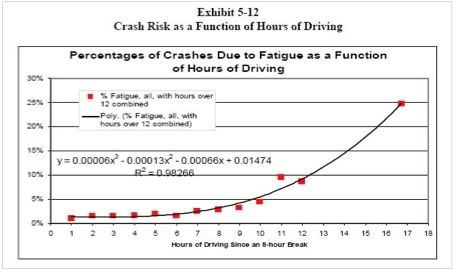U.S. trucking companies want the government to keep regulations allowing truckers to drive 11 hours in a row, rather than the previous limit of 10.
The American Trucking Associations filed a petition Friday with the federal government asking officials to issue a new version of two-year-old regulations on truckers' hours to replace regulations struck down by a court in late July.
The trucking group argued that since the court's late July ruling was focused on procedural issues rather than safety concerns, the Transportation Department should keep similar regulations in place.
The DC Appeals Court ruling (PDF) paints a different picture however:

Public Citizen notes that the TIFA data, upon which FMCSA’s time-on-task multipliers were ultimately based, indicates that “the risk of fatal-crash involvement more than doubled from the 10th hour to the 11th.” Public Citizen Br. 48-
49 (citing 2005 RIA at 45 (J.A. 1665)). The actual time-on-task multiplier for the eleventh hour used in FMCSA’s model, however, was “only 30% higher than the . . . multiplier for the 10th hour.” Id. at 49 (citing 2005 RIA at 61 (J.A. 1681)). Public Citizen contends that the two steps FMCSA used to transform the TIFA data into the time-on-task multipliers were unexplained, and that they had the effect of improperly minimizing the crash risk associated with the 11th hour of driving.
First, as explained above, instead of using the crash risk figures for each hour of driving that the TIFA Study had calculated directly from the actual crash data, FMCSA derived a cubic curve of crash risk as a function of time on task. To derive the curve, FMCSA first plotted the TIFA figures for Hours 1 through 12, and then used an aggregate measure for Hour 13 and beyond. It did not, however, plot the 13+ figure at Hour 13, but rather at Hour 17. See 2005 RIA at 59 (J.A. 1679). As shown in the accompanying graph, the curve that fit those 13 points yielded a crash risk at Hour 11 that was substantially below the figure that the TIFA Study had calculated directly from the actual crash data.
Basically at the 11 hour mark the red dot marks the real crash risk as measured in the study, the black line marks where the agency tried to pretend the risk was. So the "procedural error" was cooking the books to understate the risks that the rule was exposing the public (inclusive of truck drivers) to. Keep in mind the scale of the jumps as well, the risks in the 11th hour doubled. By the way the same court 3 years ago "expressed “very real concerns” about the increase in the daily driving limit from 10 to 11 hours." and commented that the FMCSA's model "understated the risks of driving 11 hours." So this is not about some form that was not filed correctly, this is about a serious safety issue that the court brought to the Agency's attention the last time the rule was struck down which the Agency tried to conceal this time by a dishonest manipulation of the data. This Gonzalesesque obsfucation did not have a discernable purpose other than to justify the unjustifiable. Some of the findings in the ruling were about violated procedures but this was not just about a "procedural error"
No comments:
Post a Comment